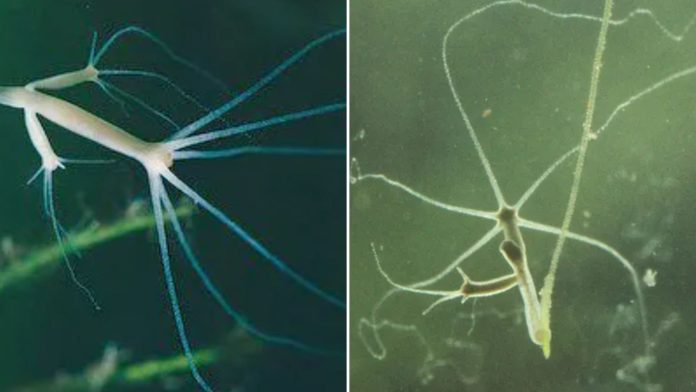Unbelievable Discoveries: Meet the Brown Hydra, the Eternal Cancer-Spreading Creature!
Scientists are scratching their heads over a peculiar creature known as the brown hydra, which not only spreads a contagious cancer but also seemingly defies death itself. Intrigued yet? Let’s dive into how this jellyfish-like species could help unravel the mysteries of cancer and evolution.
What Makes the Brown Hydra So Fascinating?
Brown hydra, a tiny and unassuming creature at just 25mm long, has become the focus of cutting-edge research. Found in aquatic habitats such as ponds, lakes, and rivers, these remarkable beings boast impressive longevity that has fascinated biologists for years. However, recent studies have unveiled a darker side—this creature has the terrifying ability to transmit cancer.
Researchers from France’s National Centre for Scientific Research (CNRS) are investigating how these hydras pass down their cancerous traits through generations while also emphasizing the potential human impact on such diseases.
How Does the Brown Hydra Spread Cancer?
In a groundbreaking study, evolutionary ecologist Sophie Tissot highlighted an alarming possibility: human activities may unintentionally foster conditions that enhance the spread of cancer among the brown hydra. Imagine that! The very actions we take in our environment could be creating opportunities for contagious cancers to thrive.
The findings unveiled that by overfeeding, brown hydras can develop transmissible cancers suggested to emerge through specific environmental conditions. As these seemingly immortal creatures reproduce, they can pass down their tumorous traits to their offspring, making effective understanding of cancer transmission critical for nature’s conservation.
Why is the Study of Brown Hydra Important?
Contagious cancers have significant implications for animal populations. Take the example of the Tasmanian devil—this once-thriving species has seen an alarming decline of up to 80% due to a transmissible disease known as “devil facial tumor disease.” The implications of such diseases ripple through ecosystems, threatening biodiversity and balance.
By studying brown hydras, researchers aim to unlock insights regarding how cancer proliferates in animals. They found that while some cancer strains spread rapidly, others barely survive after transmission, indicating varying levels of contagiousness. Understanding these dynamics within brown hydras could provide invaluable knowledge that translates to saving endangered species suffering from similar fates.
Challenging the Hunt for Cures: Insights from Brown Hydra Research
The goal of this research isn’t just to chart how cancer spreads within these organisms—it’s about creating actionable insights that can transcend species. Dr. Antoine Dujon, a key contributor from the study, pointed out that tracking cancer’s evolution from that “patient zero” hydra helps researchers explore how transmissible cancers emerge and endure within populations.
Why is this significant? Learning how certain cancers adapt could lead to more effective treatments for other species, including humans! Although scientists remain cautious in linking findings directly to human cancers, understanding the mechanisms at play offers a wealth of opportunities for biomedical applications.
The Bigger Picture: Human Impact on Ecosystems
As ecological systems grapple with various human-created challenges, the implications of studies like those surrounding the brown hydra are profound. Tissot urges the scientific community to consider how mankind’s choices could foster environments conducive to the spread of cancers, leading to potential catastrophes across both animal populations and ecosystems.
The pressure on wildlife, compounded by urbanization and habitat destruction, prompts a critical need for informed conservation strategies. The findings surrounding the brown hydra are not merely strange oddities; they exemplify a warning echoing through our ecosystems.
Could the Brown Hydra Influence Future Research on Cancer?
Though the brown hydra’s role in human cancer remains an enigmatic puzzle, it’s clear that this small creature’s story is larger than life. By investigating how cancer operates within hydras, scientists aim to glean valuable insights that can help combat severe diseases in other animals and potentially in humans too. If we can learn to intercept cancer’s transmission in one of the simplest organisms, just think about the doors that could open for treating complex diseases across various species!
In summary, the brown hydra stands at the intersection of curiosity and dread. While it reveals dark truths about cancer transmission, it also feeds our thirst for understanding the endless nuances of life and survival. Scientists are excitedly peering into this creature’s fascinating, cancer-fueled world in hopes of pioneering innovative solutions that could safeguard wildlife and, ultimately, humanity’s health.
As we continue to unearth the secrets of the natural world, the brown hydra urges us to recognize the delicate balance of ecosystems and the importance of fostering a future free from the claws of contagious diseases. Together, let’s advocate for an environmentally aware approach to protect both ourselves and the incredible diversity of life on Earth!

